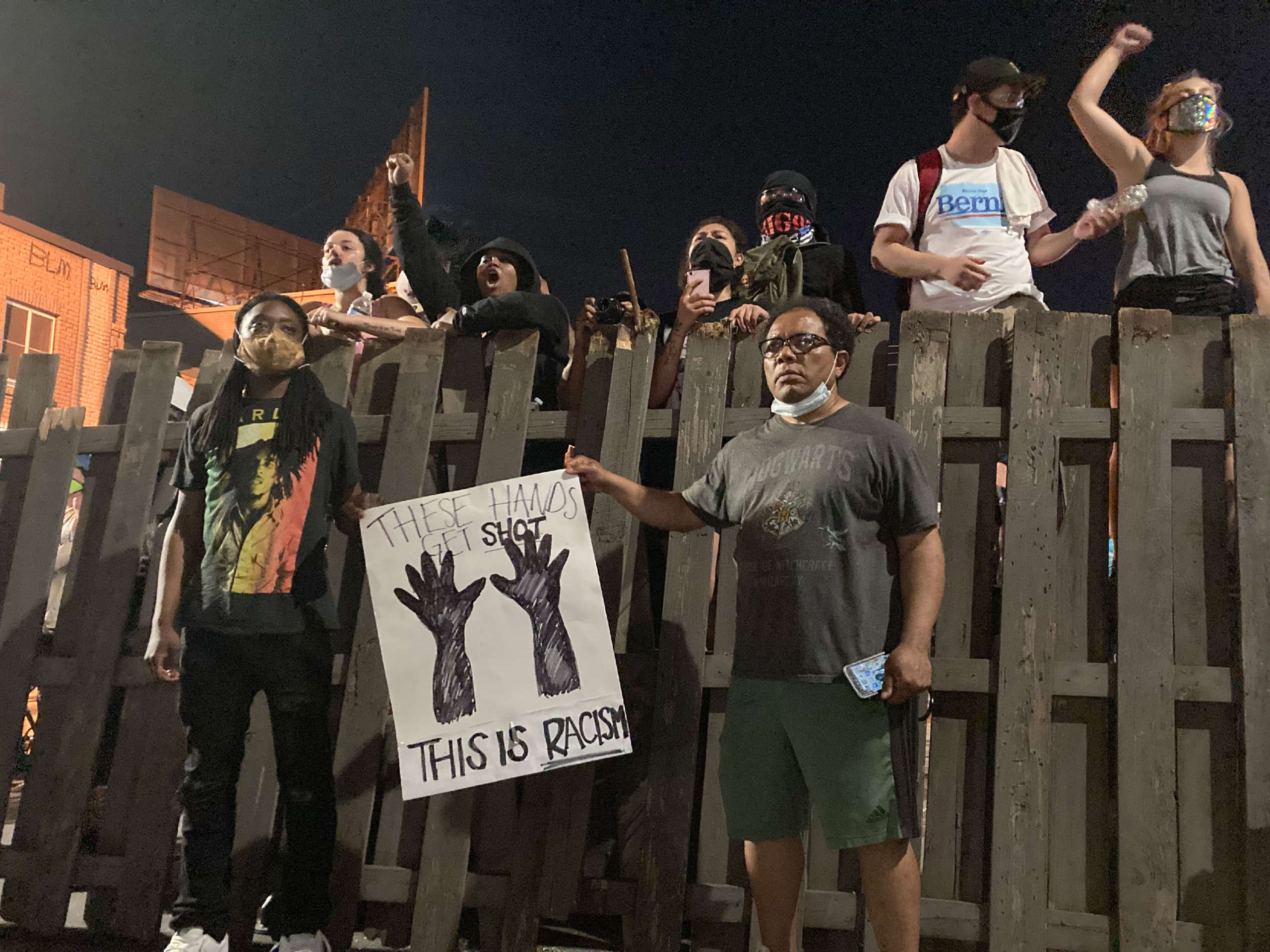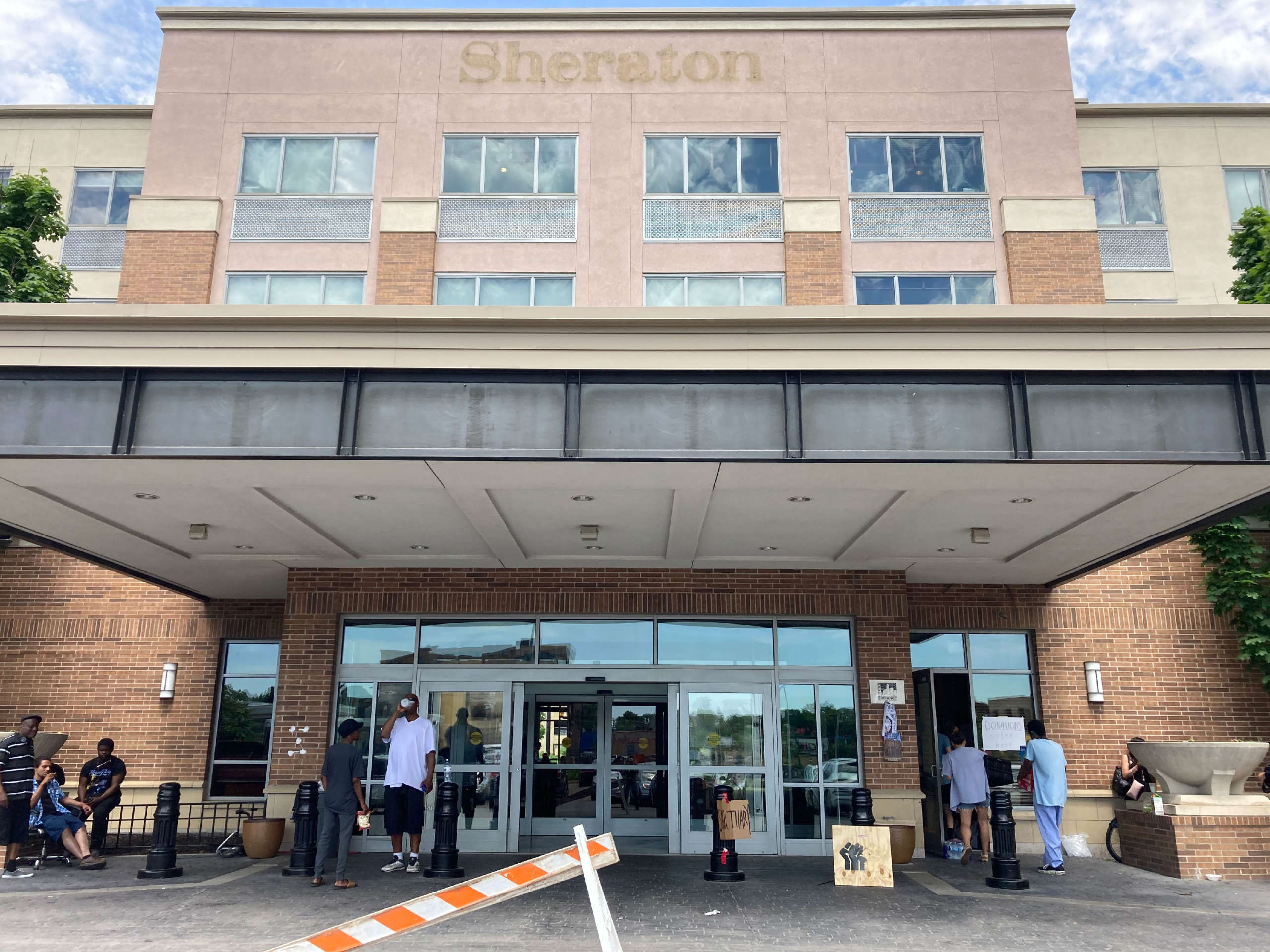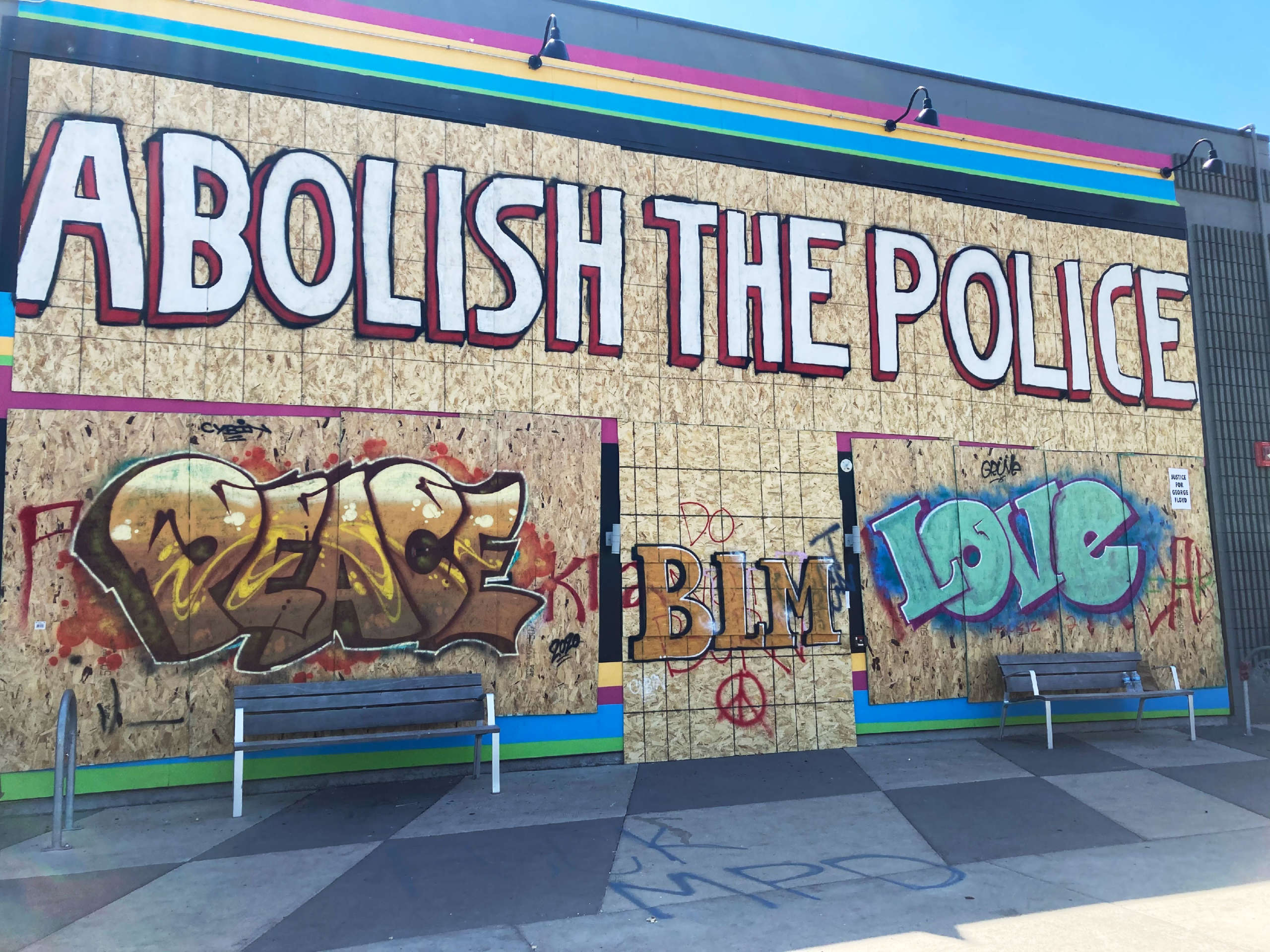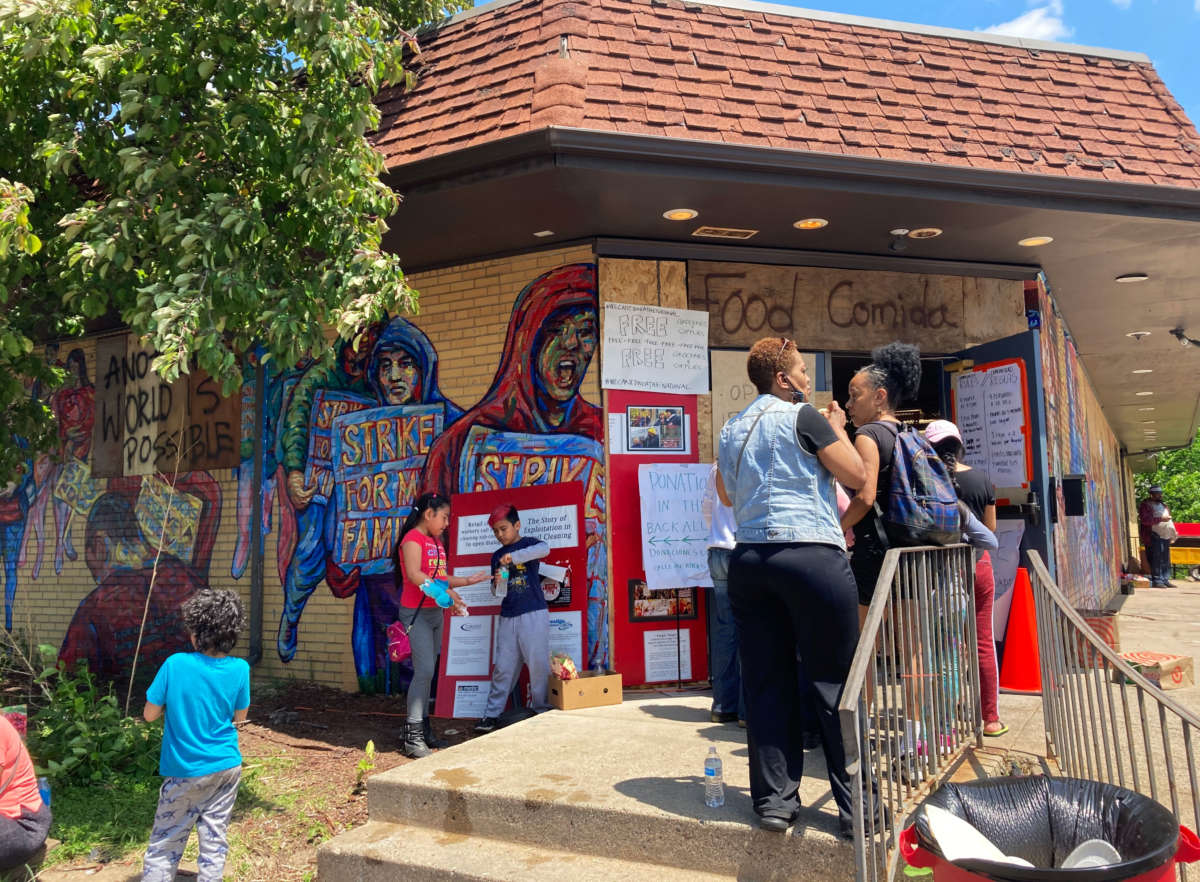Mutual aid is flourishing in south Minneapolis, where the police killing of an unarmed Black man and a revolt against state violence has left a community hungry for connection and racial justice. The alleged murder of George Floyd and the ensuing powerful uprisings have made the need to forge material support networks among neighbors all the more apparent, say activists – and they are up to the challenge.
A hotel along the Lake Street corridor that saw clashes and fires after four police officers arrested and killed Floyd is now occupied by houseless residents and activists who converted the building into a shelter for those displaced by conflict between protesters and the police. From the vigil set up to honor Floyd at 38th Street and Chicago Avenue to the parking lot of the Target store that was famously looted about two miles way, neighbors and volunteers gather on a daily basis to distribute food and household supplies from pop-up free shops while many stores remain closed.
Neighbors are also coming together to build strategies for keeping each other safe without the police, according to interviews with residents and local activists.
The alleged murder of Floyd by a white police officer while three others stood and watched — and the fiery rebellion that followed – could have torn this community apart. For days, neighborhoods south of downtown were featured on the national news as police attacked protesters and buildings were set ablaze. The uprising spread to dozens of cities across the country, where police repression of protests has further demonstrated the anti-Blackness and oppressive nature of U.S. policing.
In Minneapolis, tragedy and revolt are bringing people together in a multiracial community that prides itself on progressiveness but is also shaped by redlining, racist policing and gentrification. In communities nationwide, mutual aid efforts are providing a sense of relief and solidarity in weary neighborhoods where protesters confronted state violence and the police escalated that violence. In Minneapolis, this work is done by local community groups, families, neighbors and the young people who are a driving force behind the rebellion.
“The next steps for organizers is honestly just rebuilding … rebuilding the community, even just rebuilding our strength,” said C’Monie Scott, a 22-year-old Black activist who gathered with hundreds of other people to rally at the vigil Monday night, one week after Floyd’s death. “We’ve been shut down, even though we’re getting stronger and stronger, it’s still the fact that [the police] have done so much to us. Yes, they are breaking us down … but all I know is to just keep going.”
Scott spoke to Truthout just before midnight, when dozens of protesters were defying a 10 p.m. curfew to hold a speak-out at the vigil. By then, barricades had been erected to keep out the police, who forcefully cleared the area on Saturday night as National Guard troops moved into the city. People ran to the barricades when police passed by after curfew went into effect, but for once the cops did not escalate, and a space declared sacred was left in peace.

Organizing Food and Safety Without Police
Hundreds of people fill the intersection during the day, paying their respects at the vigil and sharing meals. Barbecues are set up in the street; friends and neighbors line up for free tacos and chicken. Families and volunteers hand out groceries, diapers, first aid supplies and fresh produce from folding tables and the trunks of their cars.
The shell of a nearby corner store was converted into a free food shelf by Centro de Trabajadores Unidos en la Lucha (CTUL), a local workers center that organizes for better wages and working conditions. Neighbors file in and out with groceries. The organization sprang into action as soon as the protests started last week, handing out masks and personal protection equipment to protesters and gathering donations of food and water.
“We are getting so many donations and so many people coming to pick up groceries and other items. My role has been to sort the different donations that come through,” said Sanethea, a CTUL member. “It makes me feel great to see our community come together after this tragedy.”
Isabela Escalona, CTUL’s communications director, said her group is both providing food for pickup and delivering groceries to homes. It’s just one of many examples of food distribution in south Minneapolis. Truthout spoke to a number of people distributing food on the street who were not part of a specific organization, including families and former residents who had moved away and come back to help. Other mutual aid groups have been delivering food since the beginning of the COVID-19 pandemic, when Minnesota issued a shelter-in-place order to prevent the virus from spreading.
“Transit had been suspended and it’s hard to get around, and if all the grocery stores are only open in the suburbs, a lot of people are in a real situation where we need food,” Escalona said.
Escalona said there is also “radical potential” for “creating systems of safety” outside of traditional policing in Minneapolis. The fires and property destruction alarmed some residents, but Escalona said the “rightful rage” did not appear from thin air. Activists have pushed the city to defund and even abolish the police force for years, and their frustration was punctuated by the fatal police shootings of Jamar Clark and Philando Castile in 2015 and 2016 — and now, George Floyd.
The rebellion has raised difficult questions for people living in south Minneapolis, especially those who own property or benefit from white privilege. But from the ashes of destruction comes the opportunity to build something new.
Over the weekend, hundreds of people met in a nearby park and began sketching out neighborhood-level initiatives to keep each other safe from the police and suspected groups of white supremacists rumored to be threatening homes, according to Escalona and other residents.
After the meeting in the park, a letter distributed by a group of anonymous neighbors suggested strategies for preventing fires without calling the police. Another letter questioned the idea that “outside agitators” could be blamed for the destructive protests. That letter, distributed by “white long-term residents of South Minneapolis,” called on other white residents to acknowledge their role in gentrification and creating the conditions for unrest, particularly among youth of color, who are disproportionately targeted by police when white people demand “safer” neighborhoods.
“We have been out every day to join our Black neighbors in protest and we know that it is mostly the youth out in the streets: an intelligent youth, a caring youth, but an infinitely enraged youth,” the letter reads. “And who are they mad at? Us. All of us who have said time and again that our property, our city, our stuff is more important than their lives. All of us who have no doubts that the police are there to protect us.”
“We are starting to figure out how we can keep ourselves safe and protected, we are seeing the potentials for community safety beyond policing,” Escalona said. “We’ve known for a long time that police are not protecting people, they are escalating situations, they are making more violence, and if their goal was community safety, it’s not working.”
A Hotel Repurposed for the Houseless
A mile up the street from the food shelf and vigil, the Sheraton Midtown Hotel has been repurposed as a shelter for residents who were camping in tents or living outside before buildings were burned and the National Guard was called in. Young volunteers, both housed and houseless, wear coronavirus masks and staff the front desk; the lobby and bar are now meeting spaces where free meals are served. A cardboard sign by the concierge’s desk announces the schedule for daily general meetings for residents.
Like many cities, in Minneapolis, infrastructure for mutual aid efforts such as free food delivery and distribution already existed before the rebellion and had grown during the outbreak of COVID-19. The shelter-in-place order issued for the COVID-19 outbreak also prevented police from evicting houseless people living in tents or on the street, and before the uprising, several encampments were established in public areas. The extent of homelessness in Minneapolis was suddenly visible, according to Sarah Jane Keaveny, a public health nurse at the Sheraton Hotel.
“It was really poorly managed, and that caused this big wave of mutual aid,” Keaveny said during an interview in the hotel lobby on Monday. “Because, I think, encampments and street homelessness is kept really invisible in this city. Then, for the last few months in the time of COVID, to be so visible was like this weird juxtaposition where everybody was supposed to be quarantining, and then this huge tent city pops up.”
Keaveny said the city was reluctant to make life “too comfortable” for the campers and rejected permits for water delivery and portable toilets. For weeks, advocates pushed local authorities to open hotels for people living on the streets with little success. Then came the rebellion, which brought a heavy police presence and saw a number of large buildings burned, sending ashes and smoke into the air.
“You come out, you wake up, and all you smell is smoke,” said Brookie Flying Hawk, who was camping outside before moving into the hotel.
Keaveny said the hotel project came about quickly over the weekend. On Thursday, two houseless people and an advocate were on their way to a suburban hotel to escape the smoke and chaos but missed the bus. They booked rooms in the Sheraton, and then decided not to leave. Dozens of people showed up to support them and guard the hotel from the rage and heavy policing on Lake Street. Soon the group was negotiating with the hotel owners, and more people from the encampment moved in. It all came together quickly, even as unrest filled the streets.
“We built a system for checking in, worked with the hotelier … building a system that can house 90 people in a matter of hours is unheard of, when you are thinking about the [existing social services] system and how it works,” Keaveny said. “And then to just watch it happen was just like, well, I guess you can just bring people into rooms that exist, and it’s fine.”

Keaveny said the hotel has not received much media attention, but word spread quickly through social and mutual aid networks, and soon food and monetary donations were pouring in. Brookie Flying Hawk’s friend, Marti Mar, joined her for dinner in the hotel lobby on Monday and signed up for a room. Mar said staying in the hotel could provide opportunities for getting involved in activism.
“I would like to do whatever I can to help my fellow Native Americans,” Marti Mar said.
“This Is a Hard Reset”
This article is just a small snapshot of the mutual aid and organizing in south Minneapolis. In two days, this reporter learned about a number of groups organizing political initiatives and mutual aid, including the Black Visions Collective, Reclaim the Block, the Little Earth Residents Association, the American Indian Movement, the Black Immigrant Collective, Ten Thousand Things Theater, and many others.
Such efforts are underway in other cities as well, bolstered by years of organizing and mutual aid infrastructure established during the COVID-19 outbreak. In Chicago, where cops cracked down on anti-police brutality protests this week and the city imposed a curfew and briefly shut down public transit, the Chicago Freedom School opened its downtown office to provide resources and shelter to protesters. The Chicago Community Bond Fund received so many donations to bail people out of jail that its website crashed, according to the Chicago Reader. Activists in New Orleans have provided material support to a group of striking Black sanitary workers, and organizers are promoting the strike at ongoing Black Lives Matter protests. These are just a few examples.
In interviews, Minneapolis activists and residents also described friends and neighbors coming together spontaneously during the rebellion to put out fires, distribute food and water, pull violent outsiders from protests, protect community infrastructure and work toward neighborhood safety without police. All of this was done despite curfews and a brutal law enforcement crackdown. Dan Raskin, a local renter and community member, said police shot rubber bullets and marker rounds at him and several friends as they attempted to put out a fire with hoses and buckets of water.
“We realized, ‘Okay, the cops are out here clearing shit violently,’” Raskin said during an interview in the local park.
For days, there were rumors fueled by politicians and social media that “outside agitators” had ignited the uprising in Minneapolis that captured the nation’s attention. Raskin had at one point suspected white supremacist infiltrators. However, reviews of police records show that most people arrested were from Minnesota, if not Minneapolis proper. While outsiders of varying motivations were likely present, Raskin, like others who witnessed the rebellion, have concluded that the rebellious energy of the protests was the result of decades of anti-Black police attacks and escalation that pushed crowds largely composed of local youth, thirsty for justice and clamoring for a better world, to the edge.
“This is militant rage energy,” Raskin said.
The nightly demonstrations demanding justice for George Floyd in Minneapolis have made an impact, and there have been some victories. The local school district terminated its $1.1 million contract with the Minneapolis Police Department, putting a plug in the school-to-prison pipeline. On Wednesday, the three cops who watched as Officer Derek Chauvin knelt on George Floyd’s neck for nearly nine minutes were charged with aiding and abetting murder. Protesters had demanded charges against the former officers for a week. Significantly, members of the city council are now listening to police abolitionist groups and considering whether to disband the police department and replace officers with a “non-violent” public safety office.

Meanwhile, young people in Minneapolis are now putting their energy toward rebuilding, organizing and mutual aid.
CiCi Battle is the director of Young People For, a group that supports Black, Brown, disabled and LGBTQ youth who are organizing around a radical ethos. Young People For is currently supporting a number of young activists working in Minneapolis. In an interview, Battle said the rebellion in Minneapolis should not be misunderstood as young people simply expressing anger or looking for an opportunity to lash out. They have specific demands and want systemic change.
“You have Black folks and you have Brown folks who are organizing, and even white folks who are saying, ‘enough is enough, the murder of George Floyd is horrible, and incremental change isn’t enough,’” Battle said. “And what the push and the energy that you see and feel from this kind of evolution into mutual aid are people coming together and understanding that the current system does not work for all.”
In Minneapolis and across the country, Battle said, young people are standing up to say they want a different future and a better world.
“This is a hard reset, and young people are not going to allow us to go back to the way things were, because they understand that it’s not working,” Battle said.
For C’Monie Scott, the future has immediate tasks at hand. Along with a crew of other young activists who attended the speak-out at George Floyd’s vigil Monday night, Scott started a new organization called We Can’t Breathe and is raising funds for community rebuilding efforts.
“After this, it’s just rebuilding…. All we can do is move up,” Scott said.
Join us in defending the truth before it’s too late
The future of independent journalism is uncertain, and the consequences of losing it are too grave to ignore. To ensure Truthout remains safe, strong, and free, we need to raise $43,000 in the next 6 days. Every dollar raised goes directly toward the costs of producing news you can trust.
Please give what you can — because by supporting us with a tax-deductible donation, you’re not just preserving a source of news, you’re helping to safeguard what’s left of our democracy.
